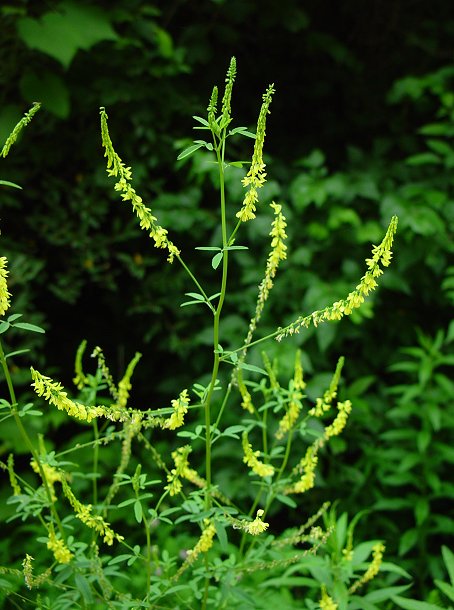Melilotus officinalis (L.) Lam.
Yellow Sweet Clover

Introduced
CC = *
CW = 3
MOC = 69
© DETenaglia
Melilotus officinalis (L.) Lam.Yellow Sweet Clover | |
 |
Introduced CC = * CW = 3 MOC = 69 |
© DETenaglia |
|
Family - Fabaceae/Faboideae Habit - Annual or biennial forb from a stout taproot. Stems - Ascending to erect, to 1.5 m, branching, longitudinally ridged, glabrous to sparsely pubescent, with musky scent when cut or crushed.
Leaves - Alternate, pinnately trifoliate, stipulate. Petioles 0.5-2.0 cm long, the terminal leaflet with the stalk 2-7 mm long. Stipules hairlike, 5-8 mm long. Leaflets 5-30 mm long, 2-12 mm wide, oblanceolate to obovate or elliptic, the lateral leaflets usually slightly shorter than the terminal one, symmetric, angled or slightly tapered at the base, rounded at the tip, the midvein usually extended as a minute, sharp point at the very tip, the margins sharply and finely toothed, the basal portion often toothless, the upper surface glabrous, the undersurface moderately pubescent with fine, appressed hairs, the venation pinnate, the secondary veins ending in the teeth. Center leaf with petiolule to 5 mm long. Lateral leaflets with petiolules to 1 mm long.
Inflorescence - Elongate spikelike axillary racemes 5-16 cm long at stem tips, with numerous flowers, the stalks 1-4 cm long, mostly longer than the subtending leaves, the bracts 0.8-1.5 mm long, linear to hairlike, inconspicuous, persistent, the flower stalks 0.5-2.0 mm long, downward-curved.
Flowers - Corollas papilionaceous, yellow, the banner 4-5 mm long, 2.2-2.5 mm wide, about as long as the wings and keel. Stamens diadelphous, 4 mm long, the filaments glabrous, the anthers yellow. Ovary 1.2 mm long, glabrous, noticeably stalked at the base (but this often obscured by the calyx). Style glabrous, 2.7 mm long.
Fruits - Modified legumes 2.2-2.8 mm long, ovoid to oblong-ovoid, slightly flattened, short-stalked, the tip with a slender beak, indehiscent, the surfaces leathery, the surfaces with a pattern of crossnerves or with irregular cross-wrinkles, light brown to dark brown, gray, or black, 1(2)-seeded. Seeds 1.5-2.5 mm long, ovoid (usually with a shallow, broad, asymmetric notch, somewhat flattened, the surface yellow to reddish brown, smooth, usually shiny. Flowering - May - September. Habitat - Upland prairies, glades, upland forest openings, bluffs, streambanks, pond margins, pastures, fields, levees, ditches, strip mines, railroads, roadsides, and open, disturbed areas. Origin - Native to Eurasia. Lookalikes - None when flowering. Strong vegetative resemblance to M. alba. A potential lookalike is M. indicus, which has been recorded once from Missouri, near Pacific in Franklin County. Other info. - It's hard to miss this plant in early summer as it grows nearly everywhere. It is found across Missouri (though is uncommon or absent in parts of the Bootheel) as well as the entire continental U.S., and from elevations from sea level to 8,000 feet and beyond. When flowering it is easily recognized by the elongate racemes of small, yellow flowers having the characteristic bean blossom shape. Photographs taken near Alley Spring, Shannon County, MO., 6-6-03 (DETenaglia); also at Shaw Nature Reserve, Franklin County, MO, 5-19-2009 and 5-20-2022, and at Riverfront Park, Washington, Franklin County, MO, 5-27-2020 (SRTurner). |